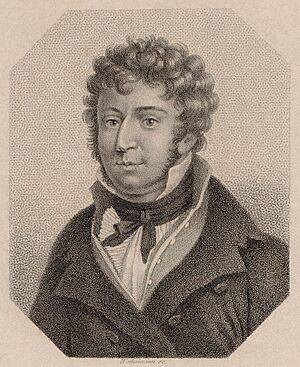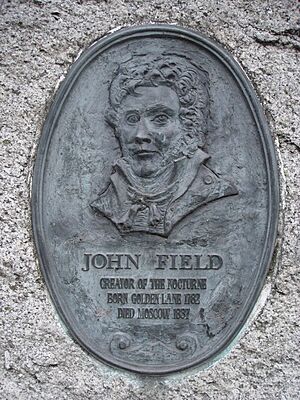John Field (composer) facts for kids
John Field (born July 26, 1782, in Dublin, Ireland – died January 23, 1837, in Moscow, Russia) was a famous Irish pianist, composer, and teacher. He is widely known for inventing the musical style called the nocturne. While other composers wrote similar music, Field was the first to use the name 'Nocturne' for a piece that had a beautiful, singing melody (called cantabile) played over a flowing, broken chord accompaniment (called arpeggiated).
John Field grew up in a musical family in Dublin. He first learned music there, especially from the Italian composer Tommaso Giordani. In 1793, his family moved to London. There, Field studied with Muzio Clementi, a very important musician. Under Clementi's teaching, Field quickly became a popular concert pianist. He traveled with Clementi to cities like Paris, Vienna, and St. Petersburg. Field decided to stay in St. Petersburg, possibly working to sell Clementi's pianos.
Many famous composers of his time thought highly of Field. His playing and music influenced great musicians like Frédéric Chopin, Johannes Brahms, Robert Schumann, and Franz Liszt. Even though we don't know all the details of his life in Russia, he certainly helped a lot with concerts, teaching, and developing Russian piano music.
Some of his notable students included the German pianist and composer Charles Mayer, the French-Russian composer Alexandre Dubuque, and the Polish pianist and composer Antoine de Kontski.
Contents
Biography
Early Life and Studies (1782–1801)
John Field was born on July 26, 1782, in Dublin, Ireland. He was the oldest son in his family. His father, Robert Field, played the violin in Dublin theaters. John first learned piano from his grandfather, who was an organist. Later, he studied with Tommaso Giordani.
John Field performed for the first time when he was nine years old, on March 24, 1792, in Dublin. People really liked his performance. In late 1793, his family moved to London. There, young John began studying with Muzio Clementi, a famous Italian musician.
Field continued to perform in public and quickly became well-known in London. Even Joseph Haydn, a very famous composer, praised Field's playing around 1795. Field kept studying with Clementi and also helped him with his instrument business. John Field's first published music came out in 1795. His first important work, Piano Concerto No. 1, was played for the first time in London in 1799, when he was 16.
Life in Russia (1802–1829)
In the summer of 1802, Field and Clementi traveled from London to Paris, and then to Vienna. In Vienna, Field briefly studied counterpoint (a way of writing music) and even met Beethoven. Beethoven praised Field's playing.
In early winter, Field arrived in Saint Petersburg, Russia. He liked the artistic life there and decided to stay. Clementi left in June 1803 but made sure Field had a teaching job and good pay. After Clementi left, Field had many concerts. He even performed at the new Saint Petersburg Philharmonic Society.
In 1805, Field went on a concert tour around the Baltic countries. The next year, he gave his first concert in Moscow. In 1810, he married Adelaide Percheron, a French pianist who used to be his student.
From 1808, Field started publishing new music, including piano variations based on Russian folk songs. In 1811, he returned to Saint Petersburg and spent the next ten years there. He was very busy, publishing many new pieces and correcting older ones. He worked with important music publishers in Russia and Europe.
In 1815, Field had a son, Leon Charpentier. He also had another son, Adrien, with his wife in 1819. Leon later became a famous singer in Russia, and Adrien followed his father's path as a pianist. By 1819, Field was quite wealthy. He even turned down an offer to be the court pianist.
In 1821, Field and his wife gave their last public concert together in Moscow. Adelaide left Field soon after, taking Adrien with her. Field stayed in Moscow, continuing to perform and publish his music. In 1822, he met another famous composer, Johann Nepomuk Hummel.
Later Years and Death (1830–1837)
By the mid-1820s, Field's health began to get worse. He performed less often. By the late 1820s, he was very sick. Field went to London in September 1831 to get medical help. After an operation, he gave concerts in London and Manchester. He stayed in England for a while and met other famous musicians like Mendelssohn and Moscheles.
In March 1832, his old teacher and friend Clementi died. Field was one of the people who carried Clementi's coffin at the funeral. On Christmas Day 1832, Field was in Paris, performing his 7th Piano Concerto. After more concerts in different European cities, Field spent nine months in a hospital in Naples from 1834 to 1835. His friends from Russia helped him. He briefly stayed with Carl Czerny in Vienna, where he gave three concerts. Then, he returned to Moscow with his son Adrien.
John Field gave his last concert in March 1836. He died in Moscow almost a year later, on January 23, 1837, from pneumonia. He was buried in the Vvedenskoye Cemetery. Someone who was there when he died said that when asked about his religion, Field joked, "I am not a Calvinist, but a Claveciniste (which means harpsichordist in French)."
Music
| No one has quite reached these gentle, floating harmonies, these soft sighs in the air, softly sad and full of sweet sadness. Nobody has even tried this special style, especially not those who heard Field play himself, or rather, who heard him dream his music when he completely let his inspiration guide him. |
| – Franz Liszt's introduction to his edition of Field's nocturnes, 1859. |
Field became famous for his unique style of music, which he probably developed in Moscow around 1807. His music often had a melody with many small decorative notes. This melody was played over rich, flowing left-hand parts, using the piano's pedals carefully. Field also liked to use repeating musical patterns (called ostinato) and sustained notes (called pedal points). These were unusual for the music of his time.
A great example of his style are Field's 18 nocturnes and similar pieces. These works were very important in the early Romantic period. They didn't follow strict musical forms like the sonata form. Instead, they created a mood or feeling without needing words or a story (which is called programme music). These pieces were greatly admired by Frédéric Chopin, who later made the piano nocturne even more famous. Franz Liszt also loved them and published his own edition of Field's nocturnes. Liszt's introduction to this edition was a long praise for Field and his beautiful nocturnes.
Field also gave a few lessons to a young Mikhail Glinka, who later became the first important Russian composer.
Field's early piano concertos were also very influential. They played a key role in how piano concertos developed in the 1800s. Even his earliest concertos showed clever and imaginative ways of writing for the orchestra and bold, original piano parts. These works influenced composers like Hummel and Moscheles, especially their beautiful, nocturne-like middle movements. Some of Field's less known works, like his piano fantasies, were also historically important because they helped create the larger, more free-flowing musical structures of the Romantic period.
Ephemera
In Walkinstown, a suburb of Dublin, there is a road called Field Avenue. It's one of several "musical roads" named after famous Irish musicians.
John Field is briefly mentioned in the famous book War and Peace. In the story, Countess Rostova asks the family musician to play her favorite nocturne.
He is also mentioned in Tolstoy's book Childhood. The narrator says that Field taught his mother to play the piano: "Mamma was playing Field's second concerto. Field had been her master."
See also
 In Spanish: John Field para niños
In Spanish: John Field para niños
- Nocturnes (Field)



